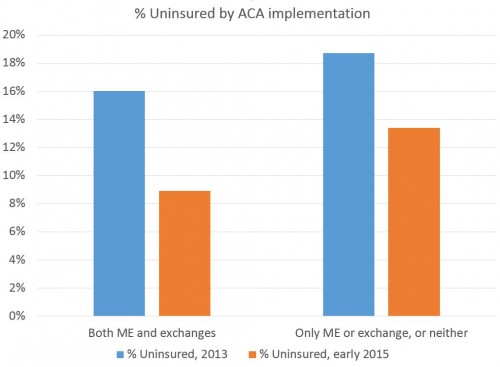I’ve long argued that the ACA is about access. It was designed, primarily, to reduce the number of uninsured in the US. We can argue about its effects on quality and cost, but it was willing to spend money to reduce the number of people in the US who lack insurance. Somehow, this is still controversial. Regardless, the data show that, with respect to its primary metric, it’s succeeding. Gallup reports that the uninsured rate has dropped from 17.3% in 2013 to 11.7% in the first half of 2015.
Moreover, states that have embraced the law more fully have seen greater reductions (ie a dose response). Here’s a chart I made from Gallup data on how the uninsured rate changed among states who adopted both the Medicaid Expansion (ME) and set up their own exchange, versus states who did one of those things or neither of them:
The states which adopted both saw the uninsured rate drop an absolute 7.1% and a relative 44%. The states that did one or neither saw the uninsured rate drop an absolute 5.3% and a relative 28%. So, even though the states that implemented both the Medicaid expansion and state exchanges had a lower uninsured rate to begin with, they still saw greater reductions than states that did one or neither.
Additionally, the seven states that saw the biggest drops in the rate of uninsured were states that adopted both. The top two were Arkansas (22.5% to 9.1%) and Kentucky (20.4% to 9.0%). Both are pretty red states.


